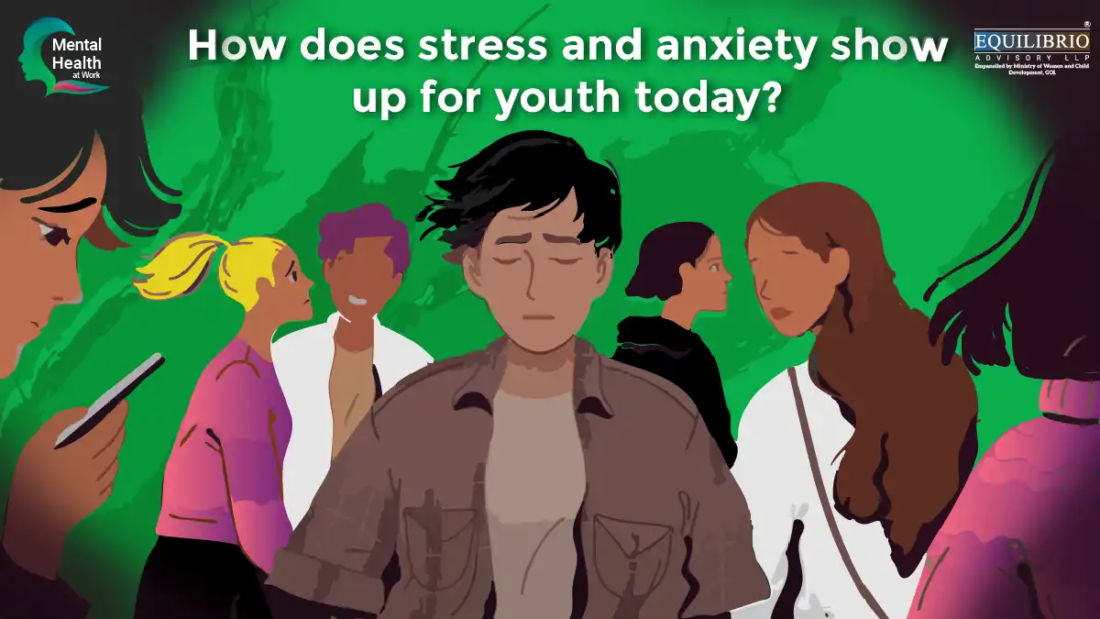Introduction
According to the World Health Organisation Anxiety disorders are the ‚ÄúWorld’s most common disorders‚Äù and affect a staggering 301 million people as of 2019. According to the same study, despite the availability of highly effective treatments, only approximately 1 in 4 people with Anxiety Disorder receive treatment for this condition. (World Health Organisation, ER 2023)
Anxiety looks different based on which demographic you focus on. The presentation of Anxiety varies across different demographic groups; women are almost twice as likely to have anxiety as men – within a given location women are around 1.5 – 3% more likely to experience anxiety or depression. (US food and Drug Administration, ER 2023).
This paper focuses on the youth and how they experience anxiety and stress. As per recent studies, the leading causes of anxiety in youth are social media, family dynamics, and academic pressure (Pal et al., 2022; Muthusamy et al., 2022; Bie et al., 2024). One of the most detrimental aspects/ experiences for children and youth, of using social media is cyberbullying. According to an MDPI article,Cyberbullying Victimisation and Social Anxiety, “Cyberbullying victims are vulnerable to negative evaluations leading to low self-esteem, and those with low self-esteem are prone to further social anxiety through the anticipation of unfavorable evaluations from others.” A study was done on a total of 501 female adolescents. It assessed cyberbullying and its relation to stress and depression. It showed that 32.5% of the female adolescents who took the survey had experienced cyberbullying. It also showed that “Cyberbullying victims were observed to have increased odds of experiencing depression and stress.”
Family dynamics can also significantly affect anxiety levels in the youth today. Dysfunctional family environments with high conflict, poor communication, and lack of emotional support can lead to elevated anxiety levels. There was a study published in the National Library of Medicine that showed there was a negative correlation between the STAI (State-Trait Anxiety Inventory) Anxiety test and the APGAR (Adaptability, Partnership, Growth, Affection, and Resolve) Family Test, showing that a “disturbed family dynamic” leads to raised levels of anxiety. (STAI is a psychological assessment used to assess levels of anxiety in individuals, and, the APGAR Family test is used to assess the functioning of a family) Furthermore, academic pressure has also emerged as one of the leading causes of anxiety in youth. The World Health Organisation highlights increasing school pressure, with a rise from 54% to 63% since 2018 (in girls). Some studies have shown that 88.4% of students experience stress and anxiety. (National Library of medicine ER 1998)
Purpose of this Study:
This article aims to explore what stress and anxiety feel like among young people, and the different ways in which anxiety manifests emotionally and physically. Additionally, it attempts to identify several factors that cause anxiety. It delves into personal and social factors such as social expectations, relationships, and family dynamics across various demographics.
The research aims to gain a better understanding of the challenges that youth face today, as well as explore some coping strategies that are used by young people today to manage their stress. The intention of this paper is not only to emphasise the importance of the issue of stress and anxiety among the youth but to also provide a nuanced first-person insight into the issue so that educators, parents, and mental health professionals can create better support systems for youth.
Additionally, this paper aims to contribute to breaking the stigma around seeking help for mental health, stress, and anxiety in the youth. I chose this topic because stress and anxiety have become increasingly common among the youth. As a 15-year-old school student myself, this is a topic that deeply resonated with me. I have personally seen how academic pressure, social media, social expectations, relationships, etc. can lead to stress and anxiety. By choosing this topic, I hope to create awareness, and encourage more open conversations around mental health and stress and anxiety.
Methodology
This paper was written as part of a summer internship with Equilibrio Advisory LLP, made possible through a connection from my school in South Bombay. I designed an online questionnaire that was directed towards individuals aged 12 to 18. It included close-ended and open- ended questions that explored how young people experience stress and anxiety, common sources (such as academic pressure, social relationships, and family dynamics), coping mechanisms (from exercise, and peer to peer support, ranging to self-isolation), etc.
Data Analysis:
Demographical data
In total, the survey collected 52 responses of which 19.2% identified as men, 76.9% identified as women, 1.9% identified as non-binary, and 1.9 % would rather not say.
73% of the responses were from people who live in Mumbai, and 86.5% attended private schools. The data that was collected was analysed to identify patterns and trends, and the open-ended questions were reviewed quantitatively. This added real-life experiences and written emotions to contextualise the quantitative data. No data that would have identified the respondent was collected, and confidentiality was maintained.
Analysis of stress responses:
The questionnaire included a question “In what ways do you experience stress and anxiety?”
The multiple choice options included in the response were, “Headache/body ache”, “Trouble sleeping”, “Racing thoughts”, “Shortness of breath”, “Overeating/loss of appetite”, “Withdrawing”, “Crying more than usual”, “Procrastination”, and “Low energy”.
Based on the demographic mentioned above, the top 4 ways in which people experience anxiety were racing thoughts (69.2% of respondents), trouble sleeping (55.8% of respondents), Low energy (55.8% of respondents), and Procrastination (51.9% of respondents). This shows that functional issues are more common as a way in which anxiety manifests, whereas physical symptoms (Headache, body aches, overeating, loss of appetite, panic attack and withdrawing) are less common.
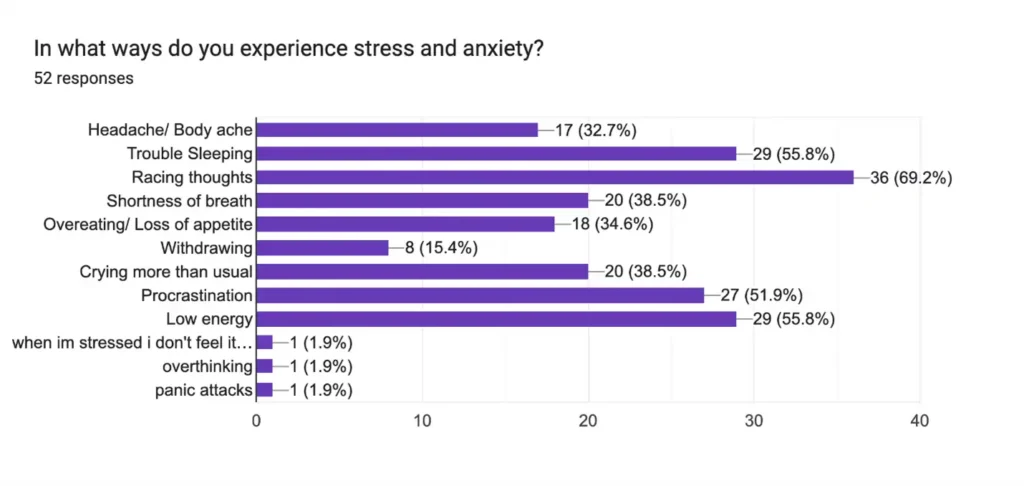
Some respondents also specified that they “may not feel it, but they begin losing hair”, experience “overthinking”, and experience “panic attacks”
Analysis of sources of stress:
The questionnaire included a question “What are the most common sources of stress and anxiety for you?”
The options for this question were ‚ÄúSchool/academic pressure‚Äù, ‚ÄúFamily expectations‚Äù, ‚ÄúSocial media‚Äù, ‚ÄúFuture/Career”, and ‚ÄúFinancial Problems‚Äù. I had added an additional ‚Äúother‚Äù option where some people mentioned they experienced ‚Äúsport pressure‚Äù and felt ‚Äúoverwhelmed by crowds‚Äù.
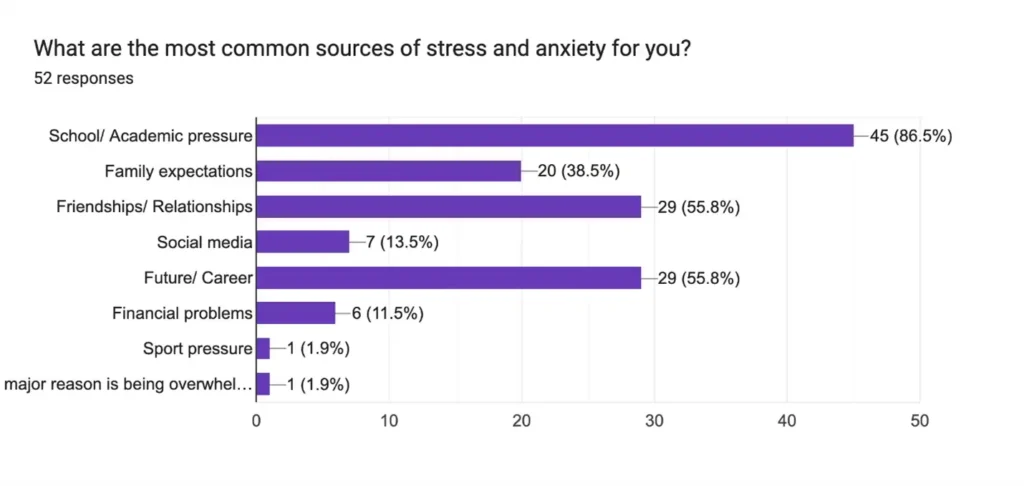
The most common sources of stress and anxiety were school, and academic pressure. It indicates that a majority of the youth feel overwhelmed by exams, tests, and other sources of academic pressure. “Friendships/relationships,” and “Future/career” both had 55.8% of respondents.
This shows that the pressure to perform causes youth the most stress, outweighing all other factors. (86.5% of respondents felt this way.) However, this graph also highlights that alongside academics, relationships/ friendships and the uncertainty of the future are also equally overwhelming for the youth.
Analysis of support systems
The questionnaire included a question “With whom do you seek help for stress or anxiety?” The options for this question were “Friends”, “family”, “Teacher”, “Therapist/mental health professional”, and “No one”. The “other” option was included here as well.
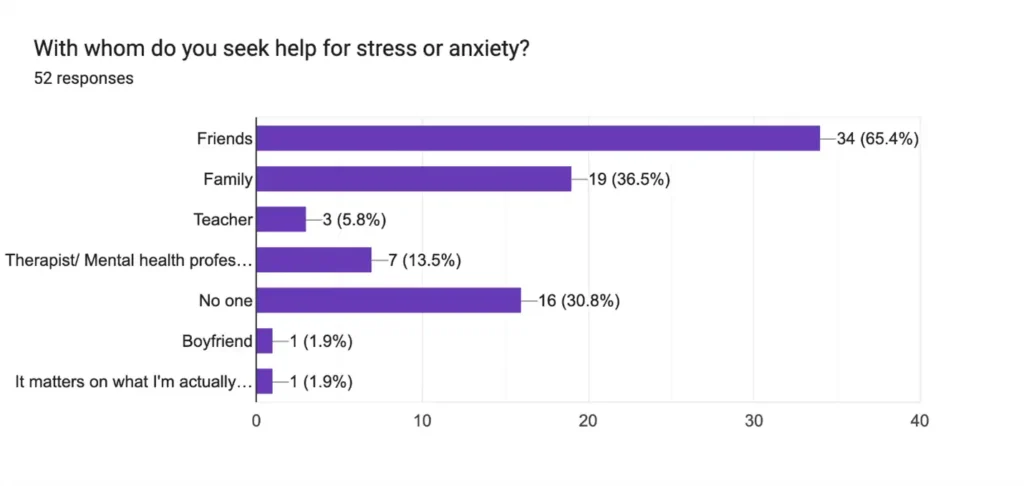
65.4% of respondents felt that their friends were their primary support system.
This shows that peer support is imperative for the emotional wellbeing of youth. 36.5% of respondents felt comfortable turning to their family for support during anxiety-provoking times. While this number is large, it is far less than the group of those who felt comfortable speaking to their friends, suggesting family might not be a safe space to speak about mental health for most people.
One person specified they seek help for their stress and anxiety with their boyfriend and another person said that it the space of support can vary depending on what they are stressed about.
Analysis of Coping mechanisms:
Music, with (48.1% of respondents choosing it) was the most popular mechanism used for coping with stress and anxiety. This could be due to the accessibility of music. Exercise was the second most common coping mechanism, with 13.5% of people opting for it. The third most popular coping mechanism was taking breaks and avoiding situations with 9.6% of respondents using that as a means of dealing with anxiety and stress. This shows that most people choose coping mechanisms that distract them from the situation such as music or exercise, rather than ones that directly assess and force them to reflect on it, such as journaling. The options for this question were ‚ÄúMusic‚Äù, ‚ÄúExercise‚Äù, ‚ÄúTaking breaks”, “Journaling‚Äù, ‚ÄúAvoiding the situation‚Äù, and, ‚ÄúBeing around nature‚Äù. In the ‚Äúother‚Äù option people wrote things like, ‚Äúall of the above‚Äù, ‚ÄúSleep‚Äù, ‚ÄúDance‚Äù, and ‚ÄúSocial media‚Äù.
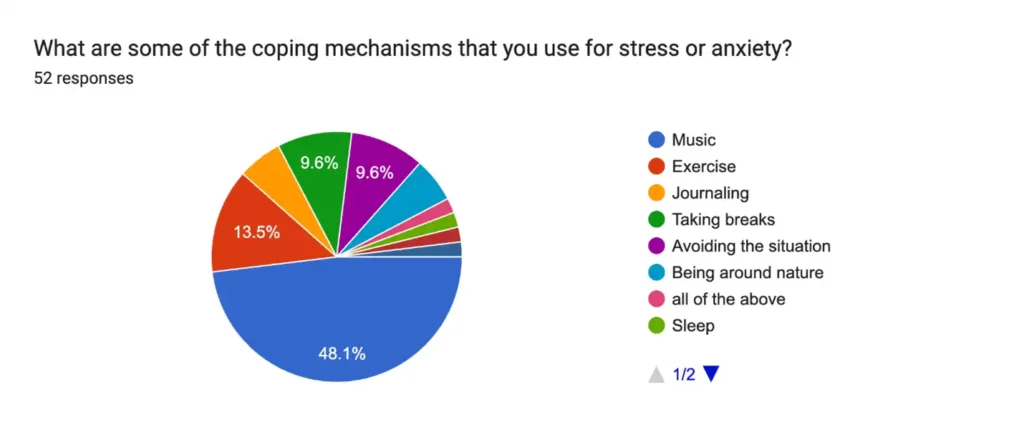
Comfort discussing mental health: Peers, Family, Mental Health professionals
When asked about how comfortable they were speaking to their peers/friends about their stress and anxiety, most respondents answered “somewhat comfortable”.
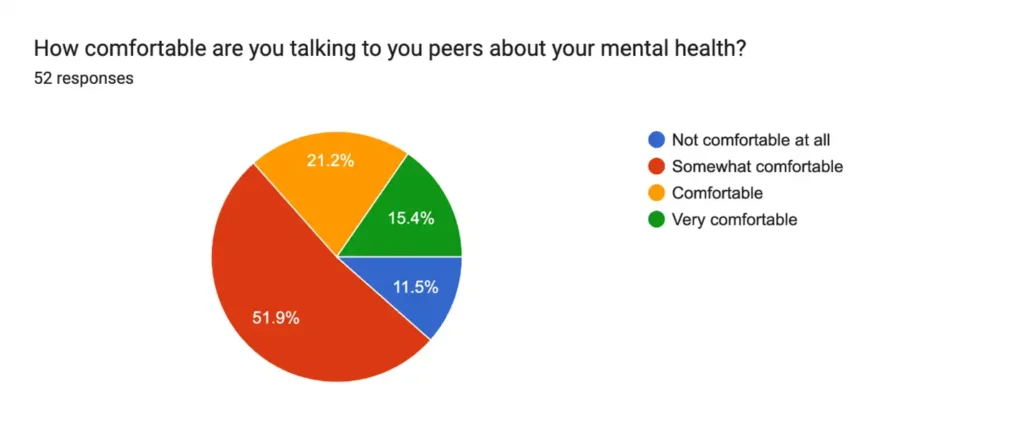
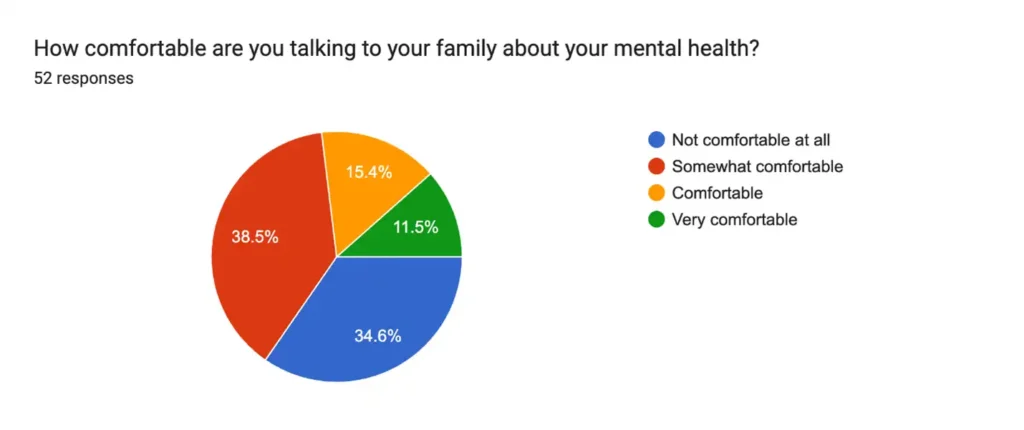
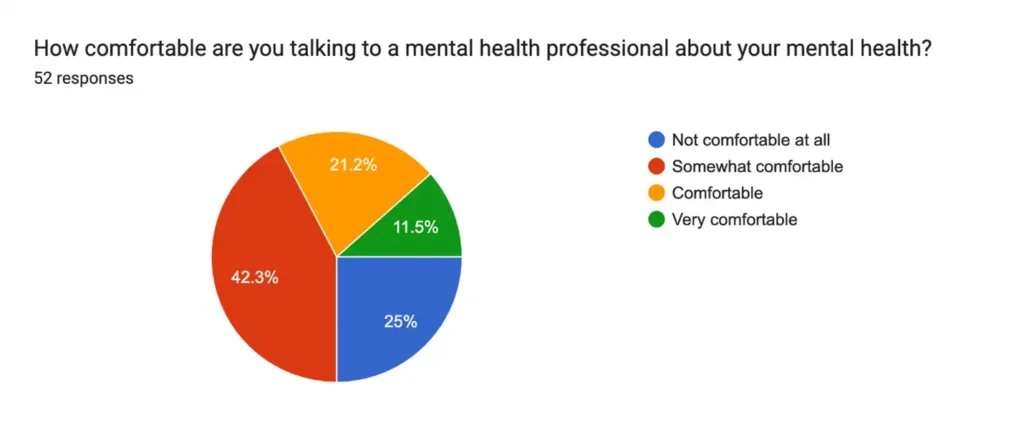
That answer was vastly different to when they were asked how comfortable they were speaking to their families about their mental health. Only 11.5% of respondents were ‚Äúnot comfortable at all‚Äù when asked how comfortable they were with talking to their peers about their mental health, whereas 34.6% of respondents answered ‚Äúnot comfortable at all” for the same question when it came to discussing it with family. Possible reasons for this are fear of judgement, age gaps, and family stigma.
This data was also different than when the respondents were asked how comfortable they felt talking to a mental health professional/therapist about their mental health. Fewer respondents replied with “not comfortable at all” when talking to a mental health professional/therapist (25%) than with their family (34.6%). This could be because of an increased sense of privacy and neutrality in a mental health professional, in contrast to judgement in a family.
Barriers in seeking support:
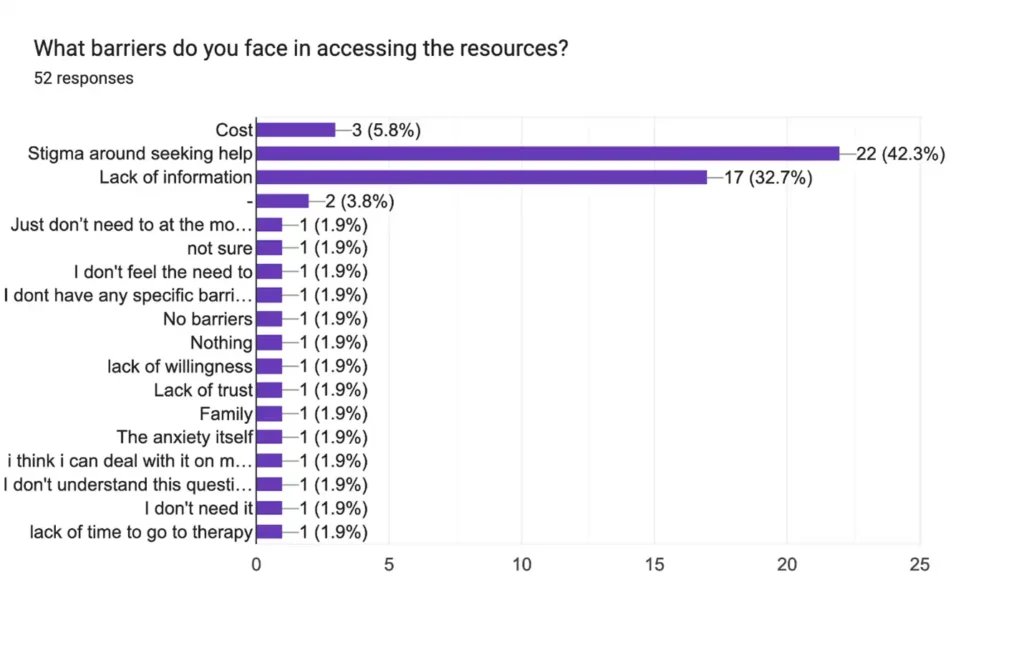
Most respondents felt that the stigma around seeking help was the most significant barrier in them seeking help for their stress/anxiety. 32.7% of respondents felt that lack of information was a barrier in them seeking help for their stress and anxiety. This shows a need for better mental health awareness and conversations resources that exist.
What support looks like for the youth:
When asked about how support would look like for them, respondents had varying opinions. However, one that resonated with most respondents was that they needed someone who would listen without judgement. 20% of respondents expressed that they wanted people who would simply listen to them. One respondent said the following.
‚ÄúListening when I feel anxious to my thoughts and not being dismissive and being affirmed that what I’m feeling is normal‚Äù
Another response that stood out was when they spoke about being alone, showing that getting space is especially important for young people.
“Quiet and peace time; I prefer spending time alone with myself to calm down”
32.6% of respondents felt that they wanted someone who would listen to them. 23% of respondents wanted someone who wouldn’t judge them. 17.3% of people wanted supportive friends and family. 17.3% of respondents wanted people who would be there, alongside them. 17.3% of people wanted someone they could talk to. 15.3% of people wanted active help and problem solving. 7.7% of respondents wanted someone who would encourage them. 7.7% of respondents wanted someone who would understand them. 3.8% of people wanted someone who would pressure them or force them to do things. 3.8% of people wanted people who would care for them and someone that they could trust. 1.9% of people felt that support meant easier workloads and realistic expectations. 1.9% of people felt the stigma around mental health decreasing would mean support for them. 3.8% of respondents wrote that self-work would mean support for them. 3.8% of respondents felt that space meant support for them.
Adult awareness of youth mental health
Furthermore, when asked what they wished schools knew about how stress and anxiety manifested in the youth today, most respondents spoke about people in authority at school undermining serious anxiety and stress issues in students.
Here are some responses received:
“I wish adults and schools knew that stress in youth today often shows up as irritability, withdrawal, overachievement, or even silence—not just tears or panic. We are under pressure to constantly perform, look perfect, and stay connected 24/7, and that takes a quiet but heavy toll.”
“I wish they would genuinely help and care about how important it is to help us cope with these thoughts and emotions. Better awareness I suppose.”
“That it’s not just a kid throwing attitude cause their irritated and something’s actually bothering them and sometimes they don’t want to talk.”
‚ÄúI wish adults realise that even small things that don’t matter to them will have an effect on our stress levels.‚Äù
“That children often deal with it but are too scared to tell anyone as they are scared of being judged.”
“i wish the conversation was more open. and also that just because someone is good at concealing it, doesn’t mean they are okay. also, it doesn’t make u any less worthy of responsibility or any less capable and you shouldn’t be looked at differently for being open about ur mental health.”
“I think that sometimes, anxiety can appear as complaints about feeling unwell, or sick in the stomach which can be mistaken for a physical illness rather than an emotional one”
‚Äúthat everybody is different and their cause of anxiety and stress can be different. if it is not something they have experienced, doesn’t mean the cause isn’t real‚Äù
“There is lot of competition and that causes stress”
‚ÄúThat it’s more common than they realise and not to think that you’re only seeking attention‚Äù
67.3% of respondents said that they wanted understanding from adults. 36.5% of them said that they wanted the conversation about mental health to be dealt with a sense of seriousness. 26.9% of respondents mentioned that they wanted adults to understand where the stress and anxiety is coming from and the causes of it. 21.1% of respondents want adults around them who know how to identify it. 13.4% of people wanted adults to know that providing solutions helped them. 7.7% of respondents wanted adults to know patience is valued by them. 21.2% of respondents wanted adults to know that academics are the cause of their anxiety. 5.6% of respondents wanted adults to know that judgement toward conversations about mental health only adds to the stigma around them. 13.4% of people wanted adults to know that feeling anxious is normal. 13.4% of respondents wanted adults to know that young people can have mental health issues despite their young age. 7.7% of people wanted adults to know that the pressure that they put regarding academic and co-curricular performance only adds to the child’s anxiety. 3.8% of respondents wanted adults to be more mindful of what they say.
Conclusion
Through the survey responses, it has been revealed that anxiety is an issue that is faced by most teenagers. By understanding what stress feels like for youth, we gain the power to reduce the stigma around mental health, stress and anxiety. The youth feel a general lack of trust and support from the adults around them, adding to their anxiety. To tackle this issue, I believe that it is crucial to have more conversations around anxiety and mental health. Some ways in which we can do this are by including conversations about stress and anxiety in school curricula. Additionally, mandating for campus counselors at school that are trained to deal with stress and anxiety, and, creating peer support groups for stress and anxiety would really help tackle this issue. Furthermore, talks about stress and anxiety management of youth among teachers, parents and adults would allow them to support the youth more. Ultimately, this research paper aims to create a more supportive and inclusive way to deal with mental health – specifically stress, and anxiety by holding up a clearer view of how stress and anxiety shape the experience of today’s youth
Written by S.B.N. (reviewed and supported by Rosanna Rodrigues (She/her) and Usri Basistha (they/she))
References:
- Anderson, Thea L, et al. “Contributing Factors to the Rise in Adolescent Anxiety and Associated Mental Health Disorders: A Narrative Review of Current Literature.” Journal of Child and Adolescent Psychiatric Nursing, vol. 38, no. 1, 30 Dec. 2024, pmc.ncbi.nlm.nih.gov/articles/PMC11683866/, https://doi.org/10.1111/jcap.70009.
- “Anxiety Noun РDefinition, Pictures, Pronunciation and Usage Notes | Oxford Advanced Learner’s Dictionary at OxfordLearnersDictionaries.com.” Www.oxfordlearnersdictionaries.com, www.oxfordlearnersdictionaries.com/definition/english/anxiety.
- Asif, Saba, et al. “Frequency of Depression, Anxiety and Stress among University Students.” Pakistan Journal of Medical Sciences, vol. 36, no. 5, July 2020, pp. 971–976, pmc.ncbi.nlm.nih.gov/articles/PMC7372668/, https://doi.org/10.12669/pjms.36.5.1873.
- Javaid, Syed Fahad, et al. “Epidemiology of Anxiety Disorders: Global Burden and Sociodemographic Associations.” Middle East Current Psychiatry, vol. 30, no. 1, 26 May 2023, https://doi.org/10.1186/s43045-023-00315-3.
- Montalbán Sánchez, J. “Relationship between Anxiety and Family Dynamics.” Atencion Primaria, vol. 21, no. 1, Jan. 1998, pp. 29–34, pubmed.ncbi.nlm.nih.gov/9557354/.
- Ridley, Matthew, et al. “Poverty, Depression, and Anxiety: Causal Evidence and Mechanisms.” Science, vol. 370, no. 6522, 11 Dec. 2020, science.sciencemag.org/content/370/6522/eaay0214, https://doi.org/10.1126/science.aay0214.
- “Women and Anxiety.” FDA, 30 Oct. 2023, www.fda.gov/consumers/womens-health-topics/women-and-anxiety.
- World. ‚ÄúRising School Pressure and Declining Family Support Especially among Girls, Finds New WHO/Europe Report.‚Äù Who.int, World Health Organization: WHO, 13 Nov. 2024, www.who.int/europe/news/item/13-11-2024-rising-school-pressure-and-declining-family-support-especially-among-girls–finds-new-who-europe-report.
- World Health Organization. “Anxiety Disorders.” World Health Organization, 2023, www.who.int/news-room/fact-sheets/detail/anxiety-disorders.
- Xia, Tiansheng, et al. “Cyberbullying Victimization and Social Anxiety: Mediating Effects with Moderation.” Sustainability, vol. 15, no. 13, 1 Jan. 2023, p. 9978, www.mdpi.com/2071-1050/15/13/9978, https://doi.org/10.3390/su15139978.
 Cart is empty
Cart is empty 


